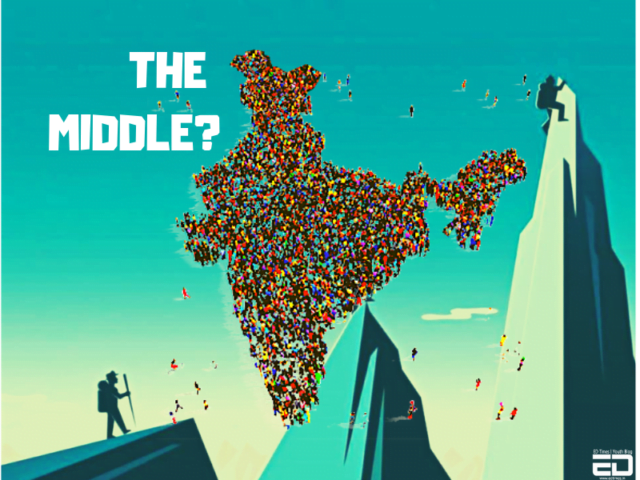Recently Mr Rathin Roy, a member of the Prime Minister’s Economic Advisory Council and Director of National Institute of Public Finance and Policy gave out a warning that India might be heading towards a structural slowdown and might soon enter what economists call a ‘middle-income trap’.
What is the Middle Income Trap?
The middle income trap is a theoretical economic situation.
After entering, it becomes difficult to leave the middle-income bracket and reach the higher income bracket, hence economists call it a trap. “In the history of the world, countries have avoided the middle-income trap, but no country — once caught in it — has ever been able to get out,” Mr Roy said.
The World Bank defines ‘middle-income range’ countries as the ones with a Gross National Product (GNP) per capita between $1,000 to $12,000 at constant prices. India had become one in 2008. Since then it’s the per capita income has been increasing slowly.

South Africa and Brazil were once sprawling economies, and then they got entrapped. Now their incomes are stagnant, instead, crime rates and corruption are increasing. This is not the kind of model India wants to follow.
Why India?
According to Mr. Roy, India might become a sufferer because of “declining growth of private consumption, tepid increase in fixed investment, and muted exports.”
This means that
- Private consumption is falling.
- Fixed investment is barely increasing.
- Exports are negligible

India never focussed on exports like China or South Korea did. So, unlike these Asian Tigers, India’s economy was not fuelled by exports, instead, it was fuelled by internal consumption.
Even when talking of internal consumption, out of a population of more than 1200 million, but only 100 million Indians are actively consuming and thus are powering the economy.
It now seems that the consumption capacity of this top 10% of the population has reached a saturation level and this is slowing down the economy.
Other Problems
Lack of Inclusive Growth
There is no doubt that India grew at an astonishing pace. But this growth was not inclusive. Inclusive growth, according to OECD website is “economic growth that is distributed fairly across society and creates opportunities for all”. This might be a reason why only 100 million Indians and not 1000 million Indians are proper consumers.
Had the growth been inclusive, the problem would not have haunted us in the first place.
Missing Manufacturing Sector
According to the three-sector model in economics, a country moves from primary (agricultural) activities to secondary (manufacturing) activities and then finally to tertiary activities (i.e. services sector). When India was growing, it did not follow this conventional pattern.
India jumped from the agricultural sector to the service sector, without tapping the manufacturing sector. The manufacturing sector has immense potential for a populated country like India for it can employ people in masses with minimal education and investment.
China, the only country with a comparable population utilized the manufacturing sector to alleviate its people from poverty. Bangladesh and Vietnam are following a similar pattern.
Also Read: Bangladesh Might Beat India In Growth By 2020: We Better Learn From This Least Developed Country
The service, on the other hand, employs a handful of highly specialized people and this requires a huge investment in human capital (eg. on education), which only the rich could afford. Hence wealth created wealth and the rich got richer.
The nature of Indian growth was faulty, no wonder we now have economic inequality on a huge magnitude. Top 1% holds 73% of the country’s wealth (Oxfam report) and unemployment is at a 45 year high. This forms a complete cycle as inequality and unemployment of the few who are capable of working further lowers consumption.
Why this matters to the young?

This is of great concern to the young because they will suffer the most. We are the ones who are about to enter the workforce now, and at this crucial stage of our life we are finding out that due to structural errors in our economy our future can be at stake.
Entering the middle income trap not only hampers the economic prospects of the country, but it also degrades the quality of life. Middle income trap is notorious for increasing corruption and crime in the country it engulfs (see South Africa and Brazil). I do not want its magnitude to multiply in Indian any further than the current level.
Young Indians, arbitrarily bracketed in the ages 15-24, will allegedly make up a third of India’s population. Not that I am warning anyone in particular, but in the history of the world, it has been the young and unemployed who bring about revolutions out of dissatisfaction.
Still, it is not too late. India is not entrapped yet. There is a lot the government can do to save us from the plight. The Modi government, known for taking bold initiatives can do so again, for good.
Image Credits: Google Images
Source: Wikipedia, NDTV, Down To Earth
Find the blogger @parihar_tweets
You’d also like to read:





























